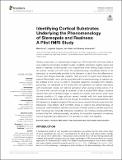Files in this item
Identifying cortical substrates underlying the phenomenology of stereopsis and realness : a pilot fMRI study
Item metadata
| dc.contributor.author | Uji, Makoto | |
| dc.contributor.author | Lingnau, Angelika | |
| dc.contributor.author | Cavin, Ian | |
| dc.contributor.author | Vishwanath, Dhanraj | |
| dc.date.accessioned | 2019-07-11T13:30:01Z | |
| dc.date.available | 2019-07-11T13:30:01Z | |
| dc.date.issued | 2019-07-11 | |
| dc.identifier | 259367505 | |
| dc.identifier | c5afc47f-90db-4c90-988c-73c12e40972a | |
| dc.identifier | 000475420600001 | |
| dc.identifier | 85069891133 | |
| dc.identifier.citation | Uji , M , Lingnau , A , Cavin , I & Vishwanath , D 2019 , ' Identifying cortical substrates underlying the phenomenology of stereopsis and realness : a pilot fMRI study ' , Frontiers in Neuroscience , vol. 13 , 646 . https://doi.org/10.3389/fnins.2019.00646 | en |
| dc.identifier.issn | 1662-453X | |
| dc.identifier.other | ORCID: /0000-0002-9445-6353/work/59465047 | |
| dc.identifier.other | ORCID: /0000-0002-8095-0537/work/64697714 | |
| dc.identifier.uri | https://hdl.handle.net/10023/18084 | |
| dc.description | Funding information: support for DV and MU was provided by the Leverhulme Trust Research Project Grant (Grant Reference RPG-2016- 269). | en |
| dc.description.abstract | Viewing a real scene or a stereoscopic image (e.g., 3D movies) with both eyes yields a vivid subjective impression of object solidity, tangibility, immersive negative space and sense of realness; something that is not experienced when viewing single pictures of 3D scenes normally with both eyes. This phenomenology, sometimes referred to as stereopsis, is conventionally ascribed to the derivation of depth from the differences in the two eye’s images (binocular disparity). Here we report on a pilot study designed to explore if dissociable neural activity associated with the phenomenology of realness can be localised in the cortex. In order to dissociate subjective impression from disparity processing, we capitalised on the finding that the impression of realness associated with stereoscopic viewing can also be generated when viewing a single picture of a 3D scene with one eye through an aperture. Under a blocked fMRI design, subjects viewed intact and scrambled images of natural 3-D objects and scenes under three viewing conditions: (1) single pictures viewed normally with both eyes (binocular) (2) single pictures viewed with one eye through an aperture (monocular-aperture); (3) stereoscopic anaglyph images of the same scenes viewed with both eyes (binocular stereopsis). Fixed-effects GLM contrasts aimed at isolating the phenomenology of stereopsis demonstrated a selective recruitment of similar posterior parietal regions for both monocular and binocular stereopsis conditions. Our findings provide preliminary evidence that the cortical processing underlying the subjective impression of realness may be dissociable and distinct from the derivation of depth from disparity. | |
| dc.format.extent | 14 | |
| dc.format.extent | 2420592 | |
| dc.language.iso | eng | |
| dc.relation.ispartof | Frontiers in Neuroscience | en |
| dc.subject | Realness | en |
| dc.subject | Stereopsis | en |
| dc.subject | fMRI | en |
| dc.subject | Parietal cortex | en |
| dc.subject | Intraparietal sulcus | en |
| dc.subject | 3D perception | en |
| dc.subject | Depth perception | en |
| dc.subject | RC0321 Neuroscience. Biological psychiatry. Neuropsychiatry | en |
| dc.subject | NDAS | en |
| dc.subject.lcc | RC0321 | en |
| dc.title | Identifying cortical substrates underlying the phenomenology of stereopsis and realness : a pilot fMRI study | en |
| dc.type | Journal article | en |
| dc.contributor.sponsor | The Leverhulme Trust | en |
| dc.contributor.institution | University of St Andrews. School of Psychology and Neuroscience | en |
| dc.contributor.institution | University of St Andrews. Institute of Behavioural and Neural Sciences | en |
| dc.identifier.doi | https://doi.org/10.3389/fnins.2019.00646 | |
| dc.description.status | Peer reviewed | en |
| dc.identifier.grantnumber | RPG-2016-269 | en |
This item appears in the following Collection(s)
Items in the St Andrews Research Repository are protected by copyright, with all rights reserved, unless otherwise indicated.

